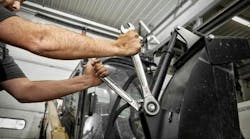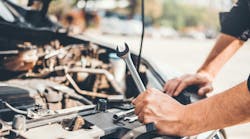Auto shops are overflowing with costly items - from tools, equipment, to parts and of course, labor. It’s not cheap to keep a repair shop’s doors open. One of the often overlooked, but necessary aspects associated with running a business like an auto repair shop is how the business accepts payments and processes transactions. At the payment terminal, a lot of auto shops might still rely on an old fashioned cash register, while others are adopting computer or tablet enabled systems, specifically to cater to the increase in electronic payments from customers. These electronic payments made through a card swipe or a tap action incur swipe fees or “interchange fees” from the banks processing the transactions. The shop owner is responsible for paying these fees each month and they quickly add up and can become an inconsistent, headache-inducing overhead cost. But, interchange fees accrued when customers make payments with credit cards shouldn’t be one of the most costly items for a shop owner. For auto shops specifically, there are ways to minimize these swipe fees and make payment processing a much easier experience at the shop.
The world is filled with different payment processors who offer different solutions in an effort to help businesses run more smoothly and reduce or eliminate the swipe fees altogether. Knowing which payment processor best fits the needs of an auto shop is the key to minimizing the fees.
First consider that many local auto repair shops don’t need the latest and greatest payment technology services. The big brand names like Toast and Square have great, robust technology, but they’re probably better suited for businesses in large cities. If a repair shop used and paid for one of these point of sale (POS) services, they’re likely paying more and using less than half of the features the service offers; making it a less-than ideal use of the business's hard-earned money.
Because auto shops most commonly work with quotes instead of set prices, payment processors that are easy to implement, customizable and flexible are usually preferred. Working with the right payment processor can increase business efficiencies, reduce stress and ultimately increase the revenue brought into the shop, allowing money to be reinvested into the business.
Auto repair shops typically have high-priced transactions, and in the past year, the average cost of motor vehicle repairs has increased nearly 20 percent. Outside factors and economic environments show no sign of transaction amounts reducing for vehicle maintenance.
Many payment processors come with either transaction fees or percentage fees as part of the deal to do business with them. Like the name suggests, transaction fees charge the business a set amount each time a transaction happens. A percentage fee is a set percentage rate, identified by the payment processor and typically doesn’t exceed 3%, that is tacked onto the total cost of a transaction. This method is typically preferred by auto shops because it is more cost-effective for high transaction amounts. For example, if a shop was charging $3,000 for a transmission rebuild and the transaction fee was 3%, the final payment needed, if the customer was paying with a credit card, would be $3,090.
However, many shops flock to a payment process method called a cash discount program. This method builds the cost to process card payments into the pricing, allowing the shop to keep the same profit margin for each sale, regardless of payment type. It also gives cash-paying customers a discount by however much the transaction percentage would’ve been if they paid with a card. By utilizing the cash discount method, shop owners can offset up to 100 percent of their processing fees.
The most common challenge or frustration faced by auto shop owners when it comes to their payment processing is a lack of local service. When bugs or issues arise in their payment terminals, it is important to have a support team nearby that can help resolve the problem quickly to avoid any disruptions in business operations. Finding a boots-on-the-ground agent to come to the rescue can be a difficult ask when using the big brand name processors mainly located in metropolitan areas.
Minimizing swipe fees gives power back to the business owner. With reduced overhead costs, more profit is coming in that can be used to improve the shop in other ways and less financial strain is being put on the owner. The best way to minimize swipe fees is to prioritize a payment processor that will work to fit the needs of the shop, support the business goals and increase efficiency for everyone


